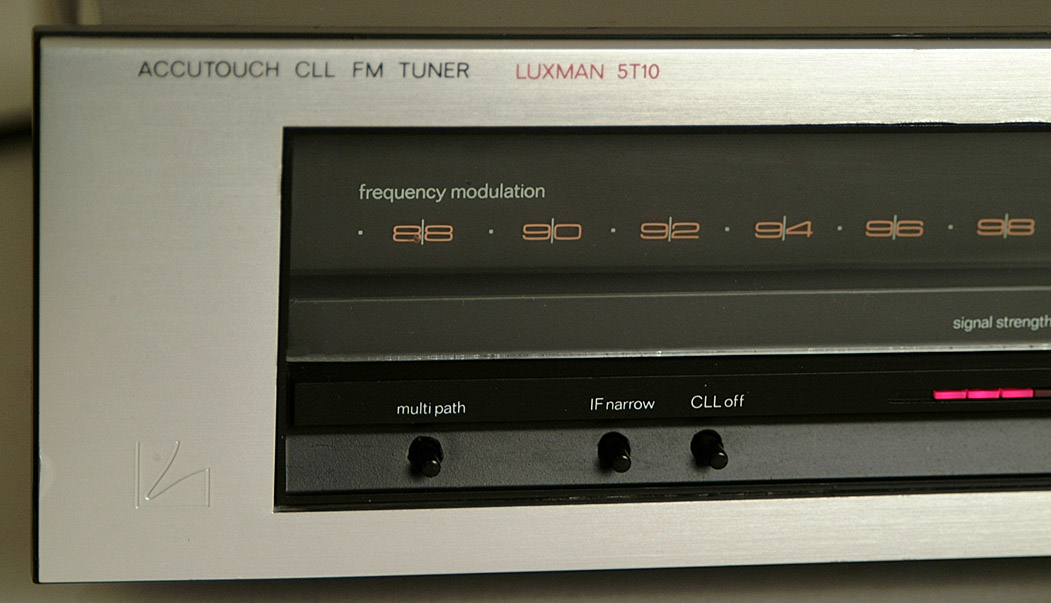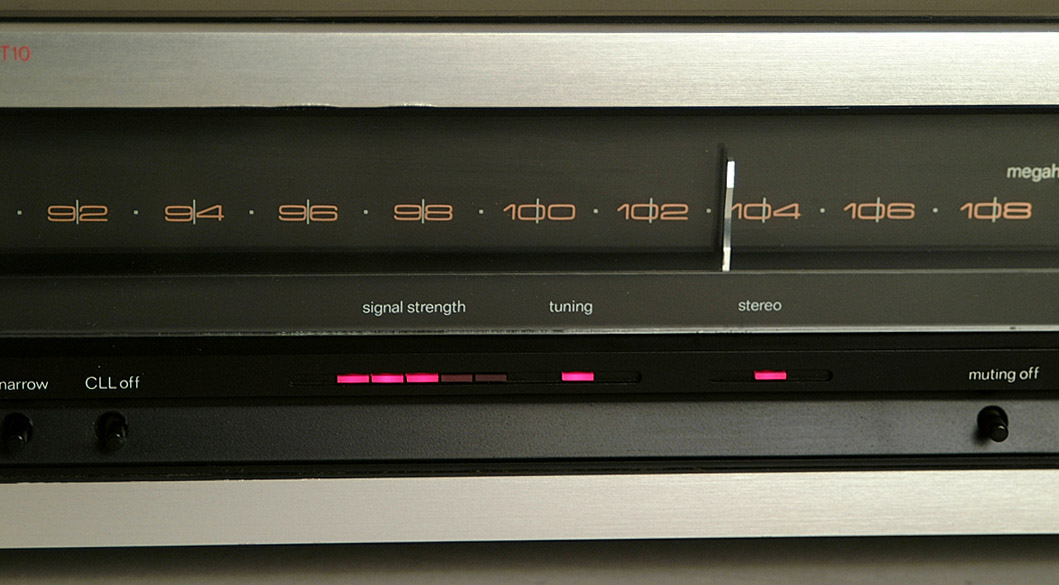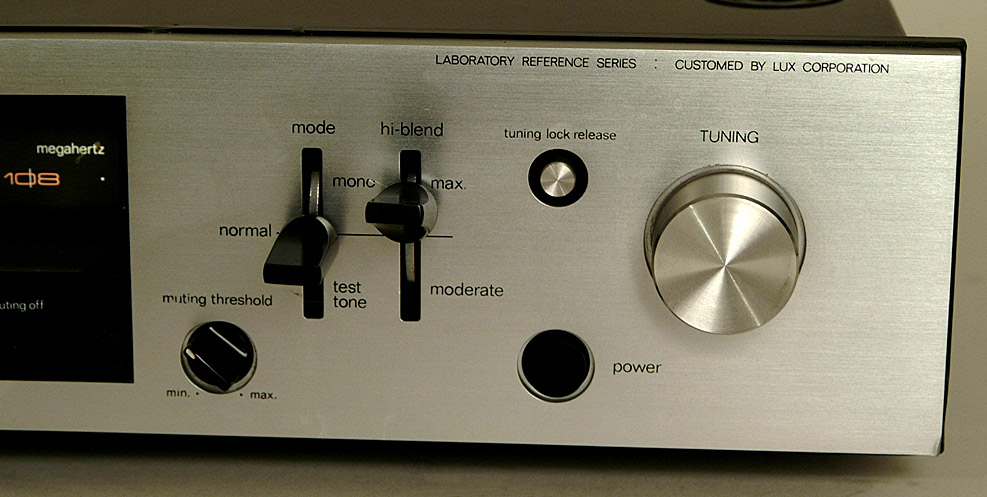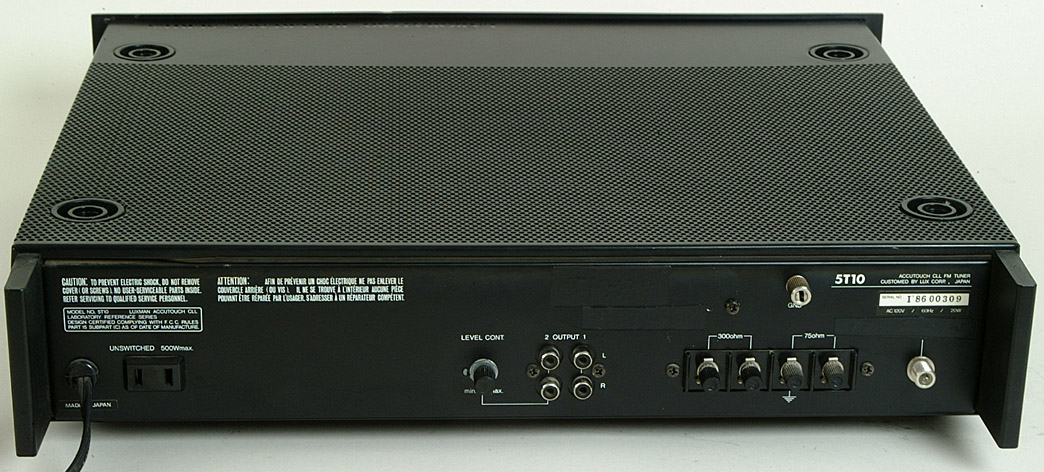Difference between revisions of "Luxman Laboratory Reference Series 5T-10"
| (13 intermediate revisions by 2 users not shown) | |||
| Line 1: | Line 1: | ||
| − | == | + | __NOTOC__ |
| − | ''' | + | == Data == |
| − | * | + | '''General''' |
| − | * | + | * Manufacturer: [[Luxman]] |
| − | * | + | * Model: Laboratory Reference 5T-10 |
| − | * | + | * Years of manufacture: 1978 - 1982 |
| − | * | + | * Made in: Japan |
| − | * | + | * Color: Silver |
| − | * | + | * Type: Analog Tuner |
| − | * | + | * Power consumption: 20 W |
| − | * | + | * Dimensions (WxHxD): 442 x 101 x 400 mm |
| − | * | + | * Weight: 7 kg |
| + | * Original price approx.: 108'000 Yen (Japan, 1978), 795 US-$, 2'000 DM | ||
| − | ''' | + | '''Connections''' |
| − | * | + | * Number of outputs: |
| − | ** | + | ** output voltage fixed: 1 V, 100 Ohm |
| − | ** | + | ** Output voltage variable: 0 - 1 V, 1.25 kOhm |
| − | * | + | * Number of inputs: |
| − | ** | + | ** Antenna: 75 Ohm, 300 Ohm |
| − | ''' | + | '''Technical data''' |
| − | * | + | * Reception: VHF |
| − | * | + | * Frequencies: |
| − | ** | + | ** VHF: 88.1 - 103.9 MHz |
| − | * | + | * Frequency response: 20 Hz - 17 kHz |
| − | * | + | * Input sensitivity: 1.7 μV |
| − | * | + | * Distortion factor: |
| − | ** Mono: | + | ** Mono: 0.05% (wide, 100Hz) |
*** 0.05% (wide, 1kHz) | *** 0.05% (wide, 1kHz) | ||
*** 0.07% (wide, 6kHz) | *** 0.07% (wide, 6kHz) | ||
*** 0.15% (narrow, 1kHz) | *** 0.15% (narrow, 1kHz) | ||
| − | + | Stereo: 0.07% (wide, 100Hz) | |
*** 0.06% (wide, 1kHz) | *** 0.06% (wide, 1kHz) | ||
*** 0.1% (wide, 6kHz) | *** 0.1% (wide, 6kHz) | ||
*** 0.4% (narrow, 1kHz) | *** 0.4% (narrow, 1kHz) | ||
| − | * | + | * Signal-to-noise ratio: 80 dB |
| − | * | + | * Channel separation: |
** Wide: | ** Wide: | ||
*** 45dB(100Hz) | *** 45dB(100Hz) | ||
*** 50dB(1kHz) | *** 50dB(1kHz) | ||
*** 45dB(10kHz) | *** 45dB(10kHz) | ||
| − | + | Narrow: | |
*** 30dB(1kHz) | *** 30dB(1kHz) | ||
| − | + | Separation: 2 signal (±400kHz) | |
| − | + | Wide:30dB | |
| − | + | Narrow:90dB | |
| − | * | + | * Equal wave selection: |
** Wide: 0.8 dB | ** Wide: 0.8 dB | ||
| − | + | Narrow: 2 dB | |
| − | * | + | * Adjacent channel attenuation: 100 dB |
| − | * | + | * IF rejection: 100 dB |
| − | * AM | + | * IF rejection: 100 dB |
| + | * AM suppression: 62 dB | ||
| − | ''' | + | '''Special Features''' |
| − | * Tuning | + | * Tuning Lock System |
| − | IF bandwidth | + | * IF bandwidth selector switch |
| − | + | * Center tuning display | |
| − | + | Test tone generator for recording calibration | |
| − | + | * Power-on delay | |
| − | Signal strength indicator | + | * Multipath control circuit |
| − | + | * Signal strength indicator | |
| − | Muting level | + | * Muting level control: variable from min. to max. |
| − | + | * Output level control | |
| − | Output level control | + | * Hi-Blend switch: Moderate - Normal - Max |
| − | |||
| − | == | + | == Remarks == |
| − | * | + | * The Luxman Laboratory Reference series made its debut in 1976. |
| − | * Highlights | + | * Highlights were the first Real Time Processed DC amplifier and the first synthesizer tuner. |
| − | * | + | * Other components of the Laboratory Reference Series included the 5M-21 power amplifier, the 5G-12 graphic equalizer, the 5F-70 parametric tone control, and the 5E-24 LED level meter unit. |
| − | * 1977 | + | * In 1977 and 1978 the Luxman Laboratory Reference Series was extended by the following units: The 5L-15 integrated amplifier, the 5M-20 power amplifier without VU meter as well as a cheaper tuner, the 5T-10 and the cassette tape deck 5K-50. The latter was probably purchased from a third party manufacturer. |
| − | * | + | * The functionality, performance and innovative design made the series unique and distinctive. |
| − | * | + | * Special features were: |
| − | ** | + | ** World's first DC amplifier and synthesizer tuner. |
| − | ** | + | ** Computer controlled cassette deck |
| − | + | Stackable components (the 4 device feet had corresponding recesses with the device standing underneath) | |
| − | * | + | * Other models in the same series: |
| − | ** [[Luxman Laboratory Reference Series 5C-50|5C-50 | + | ** [[Luxman Laboratory Reference Series 5C-50|5C-50 Preamplifier]] |
| − | ** [[Luxman Laboratory Reference Series 5M-21|5M-21 | + | ** [[Luxman Laboratory Reference Series 5M-21|5M-21 Power Amplifier]] |
** [[Luxman Laboratory Reference Series 5T-50|5T-50 Tuner]] | ** [[Luxman Laboratory Reference Series 5T-50|5T-50 Tuner]] | ||
| − | ** [[Luxman Laboratory Reference Series 5F-70|5F-70 | + | ** [[Luxman Laboratory Reference Series 5F-70|5F-70 Tone Control]] |
** [[Luxman Laboratory Reference Series 5G-12|5G-12 Equalizer]] | ** [[Luxman Laboratory Reference Series 5G-12|5G-12 Equalizer]] | ||
| − | ** [[Luxman Laboratory Reference Series 5E-24|5E-24 | + | ** [[Luxman Laboratory Reference Series 5E-24|5E-24 Level Meter]] |
| − | ** [[Luxman Laboratory Reference Series 5L-15|5L-15 | + | ** [[Luxman Laboratory Reference Series 5L-15|5L-15 Integrated Amplifier]] |
| − | ** [[Luxman Laboratory Reference Series 5M-20|5M-20 | + | ** [[Luxman Laboratory Reference Series 5M-20|5M-20 Power Amplifier]] |
** [[Luxman Laboratory Reference Series 5T-10|5T-10 Tuner]] | ** [[Luxman Laboratory Reference Series 5T-10|5T-10 Tuner]] | ||
** [[Luxman Laboratory Reference Series 5K-50|5K-50 Tape]] | ** [[Luxman Laboratory Reference Series 5K-50|5K-50 Tape]] | ||
| − | == | + | == Pictures == |
| − | * Luxman Laboratory Reference | + | * [[Luxman Laboratory Reference Series 5T-10 Front |
| − | [[ | + | [[File:Luxman 5T-10-1.jpg]] |
| − | |||
| − | |||
| − | |||
| − | |||
| − | |||
| − | |||
| − | * Luxman Laboratory Reference | + | * Luxman Laboratory Reference Series 5T-10 Front Details Left |
| − | [[ | + | [[File:Luxman 5T-10-3.jpg]] |
| − | * Luxman Laboratory Reference | + | * Luxman Laboratory Reference Series 5T-10 front details middle |
| − | [[ | + | [[File:Luxman 5T-10-4.jpg]] |
| − | * Luxman Laboratory Reference | + | * Luxman Laboratory Reference Series 5T-10 Front Details Right |
| − | [[ | + | [[File:Luxman 5T-10-5.jpg]] |
| + | * Luxman Laboratory Reference Series 5T-10 rear details | ||
| + | [[File:Luxman 5T-10-6.jpg]] | ||
| − | == | + | |
| + | == Reports == | ||
| + | * External report: website "Hifi Studio": [https://web.archive.org/web/20120513220953/http://www.hifi-studio.de/hifi-klassiker/luxman_tuner.htm] | ||
== Links == | == Links == | ||
| − | * | + | * External link: "Hifi Archive" website: [http://www.hifi-archiv.info/Luxman/1980/Luxman80_06.jpg] |
| + | |||
| + | * External Link: "Hifi Archive" data sheet: [http://www.hifi-archiv.info/Luxman/T-10/] | ||
| + | |||
| + | * External link: "Audio Database, Japan" website: [http://audio-database.com/LUXMANALPINE-LUXMAN/tuner/5t10-e.html] | ||
| − | * | + | * External link: "The Vintage Knob" website: [http://www.thevintageknob.org/luxman-Laboratory_Reference_Series.html] |
| − | + | Luxman Product Overview: [[Luxman]] | |
| − | + | [[Category:Tuner]] | |
Latest revision as of 10:18, 30 January 2019
Data
General
- Manufacturer: Luxman
- Model: Laboratory Reference 5T-10
- Years of manufacture: 1978 - 1982
- Made in: Japan
- Color: Silver
- Type: Analog Tuner
- Power consumption: 20 W
- Dimensions (WxHxD): 442 x 101 x 400 mm
- Weight: 7 kg
- Original price approx.: 108'000 Yen (Japan, 1978), 795 US-$, 2'000 DM
Connections
- Number of outputs:
- output voltage fixed: 1 V, 100 Ohm
- Output voltage variable: 0 - 1 V, 1.25 kOhm
- Number of inputs:
- Antenna: 75 Ohm, 300 Ohm
Technical data
- Reception: VHF
- Frequencies:
- VHF: 88.1 - 103.9 MHz
- Frequency response: 20 Hz - 17 kHz
- Input sensitivity: 1.7 μV
- Distortion factor:
- Mono: 0.05% (wide, 100Hz)
- 0.05% (wide, 1kHz)
- 0.07% (wide, 6kHz)
- 0.15% (narrow, 1kHz)
- Mono: 0.05% (wide, 100Hz)
Stereo: 0.07% (wide, 100Hz)
- 0.06% (wide, 1kHz)
- 0.1% (wide, 6kHz)
- 0.4% (narrow, 1kHz)
- Signal-to-noise ratio: 80 dB
- Channel separation:
- Wide:
- 45dB(100Hz)
- 50dB(1kHz)
- 45dB(10kHz)
- Wide:
Narrow:
- 30dB(1kHz)
Separation: 2 signal (±400kHz) Wide:30dB Narrow:90dB
- Equal wave selection:
- Wide: 0.8 dB
Narrow: 2 dB
- Adjacent channel attenuation: 100 dB
- IF rejection: 100 dB
- IF rejection: 100 dB
- AM suppression: 62 dB
Special Features
- Tuning Lock System
- IF bandwidth selector switch
- Center tuning display
Test tone generator for recording calibration
- Power-on delay
- Multipath control circuit
- Signal strength indicator
- Muting level control: variable from min. to max.
- Output level control
- Hi-Blend switch: Moderate - Normal - Max
Remarks
- The Luxman Laboratory Reference series made its debut in 1976.
- Highlights were the first Real Time Processed DC amplifier and the first synthesizer tuner.
- Other components of the Laboratory Reference Series included the 5M-21 power amplifier, the 5G-12 graphic equalizer, the 5F-70 parametric tone control, and the 5E-24 LED level meter unit.
- In 1977 and 1978 the Luxman Laboratory Reference Series was extended by the following units: The 5L-15 integrated amplifier, the 5M-20 power amplifier without VU meter as well as a cheaper tuner, the 5T-10 and the cassette tape deck 5K-50. The latter was probably purchased from a third party manufacturer.
- The functionality, performance and innovative design made the series unique and distinctive.
- Special features were:
- World's first DC amplifier and synthesizer tuner.
- Computer controlled cassette deck
Stackable components (the 4 device feet had corresponding recesses with the device standing underneath)
- Other models in the same series:
Pictures
- [[Luxman Laboratory Reference Series 5T-10 Front
- Luxman Laboratory Reference Series 5T-10 Front Details Left
- Luxman Laboratory Reference Series 5T-10 front details middle
- Luxman Laboratory Reference Series 5T-10 Front Details Right
- Luxman Laboratory Reference Series 5T-10 rear details
Reports
- External report: website "Hifi Studio": [1]
Links
- External link: "Hifi Archive" website: [2]
- External Link: "Hifi Archive" data sheet: [3]
- External link: "Audio Database, Japan" website: [4]
- External link: "The Vintage Knob" website: [5]
Luxman Product Overview: Luxman




